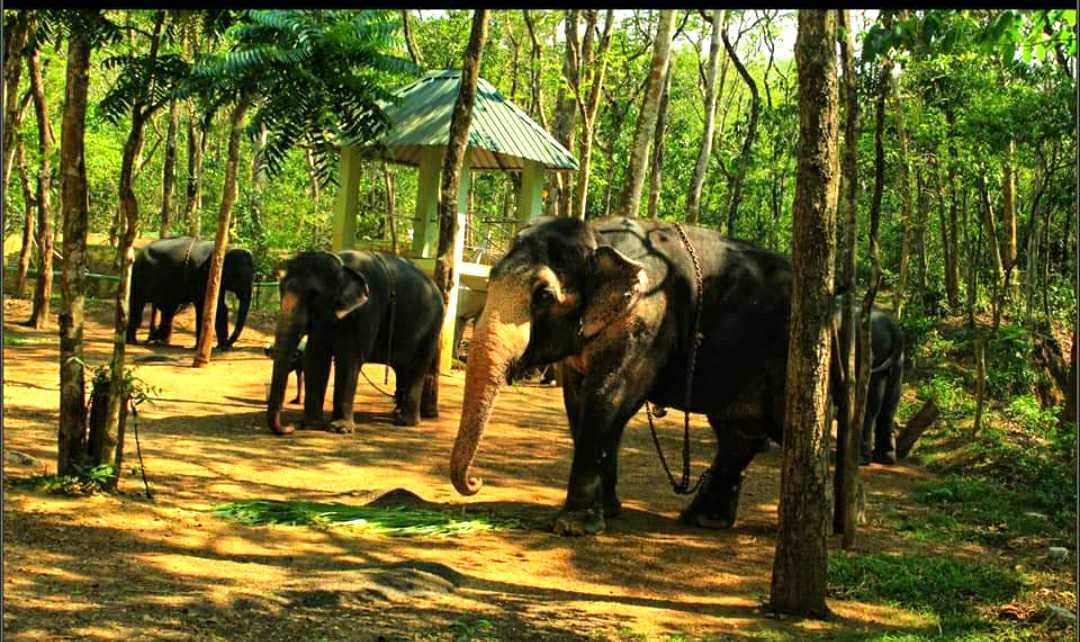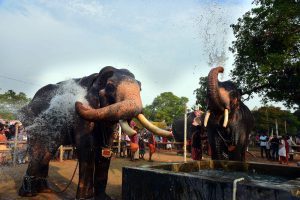The falling numbers of captive elephants is worrying for a state where the animals are an integral part of festivities across religions.

The government-run retirement camp for aged elephants at Kottur in Thiruvananthapuram. (Dhanush Mundola/South First)
Mangalamkunnu Kesavan was among the most loved elephants paraded during the annual Thrissur Pooram. The magnificent beast, caparisoned and carrying elaborate parasols, was in fact an integral part of the famous temple festival.
But his popularity was his nemesis.
Kesavan was made to crisscross the length and breadth of the state and flaunted at temple festivals and church feasts for the entertainment of so-called elephant lovers.
There was no let-up even during the hot summer months.
The relentless moving around took a toll on the animal, and Kesavan developed an acute foot disease, intestinal colic, and trunk paralysis.
When Kesavan was paraded for the last time at the Thalukulangara Shiva Temple in Thrissur district in March 2021, members of the Elephant Task Force noticed he looked weak and totally indifferent to the commands of mahouts.
A case was filed by the task force for parading the elephant without a fitness certificate. That case is still pending without action. And pleas that Kesavan be shifted to the government-run retirement camp for aged elephants at Kottur in Thiruvananthapuram fell on deaf ears.
Once its movements were restricted, former fans of this elephant began looking elsewhere for healthy and vibrant others. Suddenly, Kesavan had become a liability for its owner, Mangalamkunnu Haridas.
The captive elephant breathed its last on July 14, aged 68. Though old age was officially the reason for his death, Kesavan had been suffering from for a long time.
Over the past five years, a clutch of “highly celebrated” Kerala elephants have met with the same fate as Kesavan, some of the more popular household names among them being Mangalamkunnu Karnan, Paramekkavu Sreepadmanabhan, Guruvayur Padmanabhan and Thiruvambady Sivakumar.
But the adulation for elephants has not ebbed in the state, and a new line of the animal has now become the “most sought after”.
The problem is, says VK Venkatachalam, secretary of the Thrissur-based Heritage Animal Task Force, which works to end cruelty against captive elephants, the population of the animal in captivity in Kerala is declining at an alarming rate.
“This practice of elephant parades in churches and temples will vanish entirely in another decade,” says he.
The reason for the dwindling numbers is the high mortality rate among captive elephants, Venkatachalam explains. “On an average, at least 25 captive elephants used to die every year in Kerala,” he says.
However, the state’s captive elephant population declined at a faster pace between 2008 and 2022, from 900 to 448, an almost 50 percent drop.
In recent years, 2018 saw the maximum number of deaths – 34. This year’s toll has been 12 so far, while it was 29 in 2021, and 20 each in 2020 and 2019.
Mangalamkunnu MA Haridas, Kesavan’s owner, who lives in Mangalamkunnu village in Palakkad district, owned as many as 18 elephants in the 1996-98 period – among the largest private ownerships in the world. Today, he owns only four. “Palakkad district had 58 elephants six years ago, now it has only 28,” he told South First.
Apart from the high captivity death rate, Venkatachalam says Kerala also has a large number of the surviving captive elephants at an advanced age, which would soon be dying a natural death anyway.
Man-inflicted wounds are another reason for the death of captive elephants, Kerala Forest Department data shows. As per the data, 16 elephants with visible injuries of bad treatment were seized from private owners in the last decade and rehabilitated at the retirement home in Kottur.
The wounds are inflicted by mahouts on sensitive parts of the animal’s body, including around the foot, sides of the hip and above the tusk, so as to manage them efficiently.
Even as captive elephants vanish rapidly in the state, Kerala’s fascination for the animal’s presence at festivities continues to remain high.
The elephants are accorded demigod status – unseen elsewhere in the country – and some of the more popular among them have a fan base that can compare with that of film stars.
With the threat of Covid-19 ebbing now, the demand for the elephant at the various annual festivals has again gone up.
The problem, says V Nandakumar, president of the Cochin Devaswom Board – a socio-religious trust appointed by the state government to oversee the affairs of Hindu temples in the central districts of Ernakulam, Thrissur and Palakkad – is the non-availability of elephants needed during the rituals.
“We lost many of our celebrated elephants in recent years,” he says. “How can we maintain tradition at events like Thrissur Pooram without elephants? It is time we addressed the issue collectively.”
His solution: The government should promote donations of elephants by corporates and private individuals to centres of worship and immediately renew ownership transfers, or sale, of the beast.
In other words, Nandakumar wants the Wild Life (Protection) Act, 1972, to be amended.
When a parliamentary committee on the environment led by former Union minister Jairam Ramesh was assigned the task of suggesting amendments in the Wild Life Act to facilitate the transfer of ownership and transport of elephants, there was enormous pressure from Kerala on the committee to relax the rules.
Section 43 of the Act states that no person in possession of a captive animal shall transfer it by way of sale or offer for sale or by any other mode of consideration of commercial nature. Kerala wanted to amend this clause.
But far from amending the law, the committee recommended stringent rules even for the surrender — handing over the ownership of the elephant to a trust or a temple without accepting any money — of captive elephants. Normally, this is done to avoid legal proceedings related to selling and purchasing elephants.
The committee also suggested a blanket ban on the transfer and transport of elephants by any person having an ownership certificate.
The Kerala Elephant Owners’ Federation, which has 32 members, too, wants a relaxation of rules to get more elephants from outside for parading in the state’s festivals.
The federation’s office-bearers are currently meeting MPs from Kerala to convince them about the need to bring in more elephants from outside the state, says its general secretary P Sasikumar.

Captive elephants cooling themselves during a break from the festival parade in Thrissur. (Supplied)
Members also plan to meet Union Minister for Environment and Forest Bhupendra Yadav to seek necessary amendments to the Wild Life (Protection) Act to facilitate ownership and inter-state transfer of elephants.
In addition, efforts would be made to seek the prime minister’s intervention in maintaining the traditional charm and attraction of events such as Thrissur Pooram, where elephant parades are integral.
“The Centre had intervened in support of Jallikattu when Tamil Nadu pressured for it,” says Sasikumar. “We expect something similar from the state government.”
Incidentally, in his farewell speech in the Rajya Sabha in April, actor-turned-BJP politician Suresh Gopi made a passionate appeal to relax the wildlife protection rules to allow ownership and sale of elephants.
When contacted by South First, Kerala’s Temple Affairs Minister K Radhakrishnan said he was aware of the gravity of the situation, and would take up the matter with the Centre very soon.
Animal rights activist Venkatachalam, however, alleges that ownership transfers are anyway continuing illegally with the tacit support of the state government.
“There must be an immediate social audit of the health of all captive elephants,” he told South First.
Activists like Venkatachalam, who want better living conditions for captive elephants, oppose any move to bring in more elephants from outside, saying they would be mistreated in the state
Says activist Purushan Eloor: “Money-minded owners are parading elephants on almost all festival occasions,” he says. “They ignore the extreme weather conditions and high decibel of firecrackers bursting.”
What is appalling, Eloor told South First, is that the elephants are now being paraded even for occasions like house warmings and engagements. This just takes a toll on the health of the animal.
Venkatachalam lists other issues: The scorching heat during the festival months, long hours of parade, ill-treatment by the mahouts, and unscientific management of the elephants.
“Despite the so-called love of Keralites for elephants, they are often tethered under trees in captivity,” he says. “During the rainy season, they are forced to remain in slush pools containing their dung, urine, and rainwater. Such filthy surroundings cause diseases such as tuberculosis. Many elephants have died in the state due to foot infection, tuberculosis and impaction.”
He is also not convinced of the practice of worshipping elephants.
“It is not worshipping,” says Venkatachalam. “It is a business in the name of religion, and an abusive one at that.”

Apr 24, 2024

Apr 24, 2024

Apr 24, 2024

Apr 24, 2024

Apr 24, 2024

Apr 24, 2024